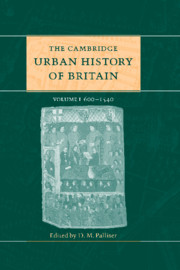Book contents
- Frontmatter
- Part I Introductory
- Part II The early middle ages 600–1300
- Part III The later middle ages 1300–1540
- 12 General survey 1300–1540
- 13 Government, power and authority 1300–1540
- 14 The economy of British towns 1300–1540
- 15 Urban culture and the Church 1300–1540
- 16 The built environment 1300–1540
- 17 London 1300–1540
- 18 The greater towns 1300–1540
- 19 Port towns
- 20 Small towns 1270–1540
- Part IV Regional surveys
- Part V Conclusion
- Appendix: Ranking lists of English medieval towns
- Select bibliography
- Index
- References
16 - The built environment 1300–1540
from Part III - The later middle ages 1300–1540
Published online by Cambridge University Press: 28 March 2008
- Frontmatter
- Part I Introductory
- Part II The early middle ages 600–1300
- Part III The later middle ages 1300–1540
- 12 General survey 1300–1540
- 13 Government, power and authority 1300–1540
- 14 The economy of British towns 1300–1540
- 15 Urban culture and the Church 1300–1540
- 16 The built environment 1300–1540
- 17 London 1300–1540
- 18 The greater towns 1300–1540
- 19 Port towns
- 20 Small towns 1270–1540
- Part IV Regional surveys
- Part V Conclusion
- Appendix: Ranking lists of English medieval towns
- Select bibliography
- Index
- References
Summary
‘Coming into Canterbury’, wrote Charles Dickens in David Copperfield, ‘I loitered through the old streets with a sober pleasure that calmed my spirits and eased my heart. There were the old signs, the old names over the shops … the venerable Cathedral towers … the battered gateways.’ For Dickens, and for the modern visitor to towns where medieval fabric can still be seen (such as Norwich, which claims to have more surviving medieval churches than any other town in western Europe), the built environment creates a powerful sense of place and a reassuring frame of reference. We can try to reconstruct the former townscape and delve behind it to study the relationship between physical settings and the attitudes which influenced the conduct of medieval life.
The construction of the built environment in medieval British towns reflected both social values and personal initiatives or personal monument making, be it repairing a bridge, erecting a conduit or adding a chapel to the local parish church. But the period was not static. Over the two and a half centuries covered by this chapter, certain developments and underlying trends can be seen.
During the medieval period, several features of construction and amenity first appeared in towns: jetties for the first floor and higher by 1300 (already in London by 1246), dormer windows by 1450 and the flooring over of halls which probably happened in profusion in towns during the fifteenth century before it was necessary or thought fashionable in the countryside. The underlying motors were the conjunction of pressure on space and the availability of cash, generated by trade and other urban pursuits (such as rents), which created the climate for innovation and display, both at the level of grand patronage in a church or the ordinary house.
- Type
- Chapter
- Information
- The Cambridge Urban History of Britain , pp. 371 - 394Publisher: Cambridge University PressPrint publication year: 2000
References
- 4
- Cited by



